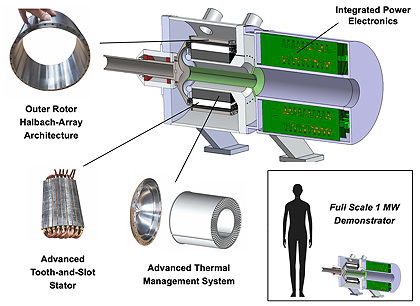The motor and its power electronics are each about the size of a suitcase and weigh less than an adult passenger.
The motor’s main components are:
• a high-speed external rotor, lined with an array of magnets with varying polarity orientations;
• a compact, low-loss stator containing an intricate array of copper windings;
• a heat exchanger to keep the components cool; and
• a distributed power electronics system, comprising 30 circuit boards that control the currents running through the windings, precisely at high frequency.
The distributed PCBs are closely coupled with the machine to minimise transmission losses and to allow effective cooling via the heat exchanger.
“I believe this is the first truly co-optimised integrated design,” says the project’s leader, Zoltan Spakovszky, who is the T. Wilson Professor in Aeronautics and Director of the Gas Turbine Laboratory at MIT.
“We did a very extensive design space exploration where all considerations from thermal management, to rotor dynamics, to power electronics and electrical machine architecture were assessed in an integrated way to find out what is the best possible combination to get the required specific power at 1MW,” he explains. “This is a high-speed machine, and to keep it rotating while creating torque, the magnetic fields have to be traveling very quickly, which we can do through our circuit boards switching at high frequency.”
To mitigate any risks, the team has built and tested each of the key components individually, and shown that they can operate as designed and at conditions exceeding normal operational demands. They will assemble the parts together later this year.
The MIT team says their 1MW motor could be used to propel all-electric regional aircraft powered by batteries or fuel cells. They envisage several 1MW motors powering multiple fans along the wings of future aircraft. The 1MW design could potentially be scaled up to create multi-megawatt motors for larger planes.

The MIT researchers are developing the motor’s components separately before assembling them to create a compact 1MW machine Image: MIT research team
Alternatively, the motor could be used with conventional jet engines in a hybrid-electric configuration that would rely on electric propulsion during some phases of a flight.
The more power a motor generates, the more heat it produces, and the more elements it needs to keep its components cool. All of these take up space and can add significant weight to the system, making it challenging for airplane applications. “Heavy stuff doesn’t go on airplanes,” Spakovszky points out. “So we had to come up with a compact, lightweight, and powerful architecture.
“I think we’re on a good trajectory,” he adds. “No matter what we use as an energy carrier – batteries, hydrogen, ammonia or sustainable aviation fuel – independent of all that, megawatt-class motors will be a key enabler for greening aviation.
“There is no silver bullet to make this happen, and the devil is in the details,” Spakovszky continues. “This is hard engineering, in terms of co-optimising individual components and making them compatible with each other while maximising overall performance. To do this means we have to push the boundaries in materials, manufacturing, thermal management, structures, rotor dynamics and power electronics.”
The MIT project is being sponsored by Mitsubishi Heavy Industries.
MIT Department of Aeronautics and Astronautics: Twitter Facebook

